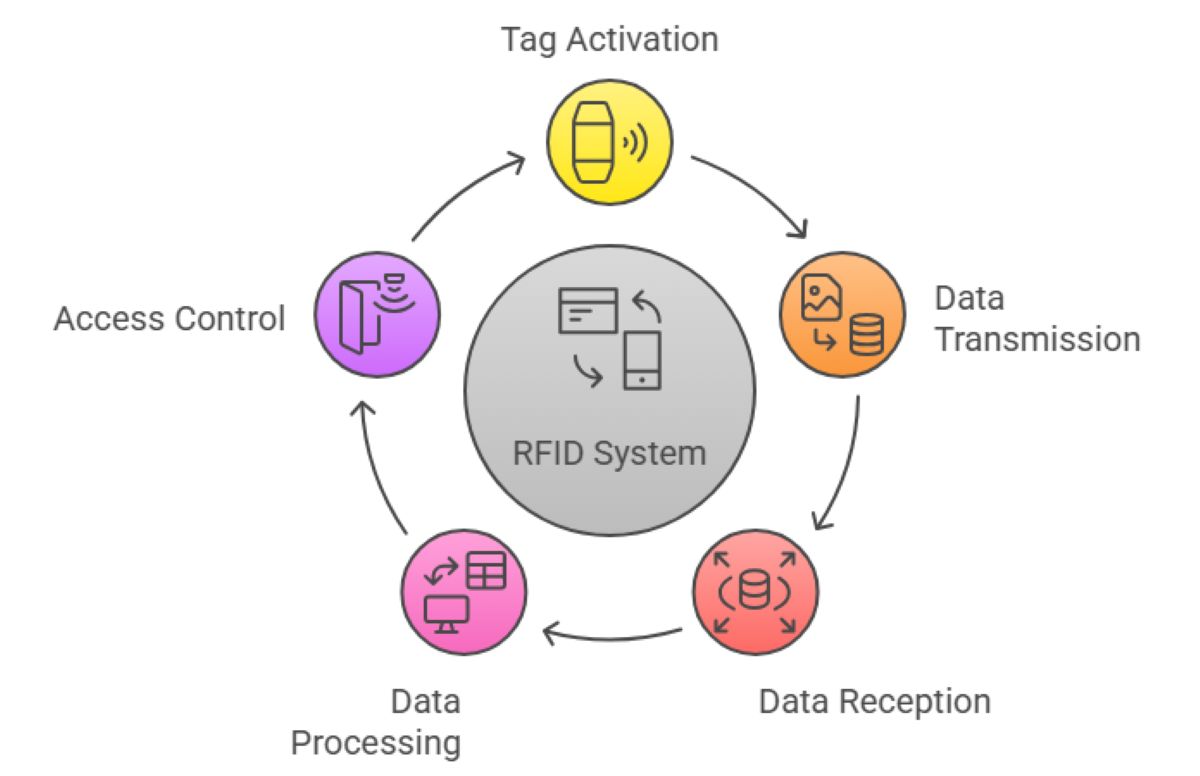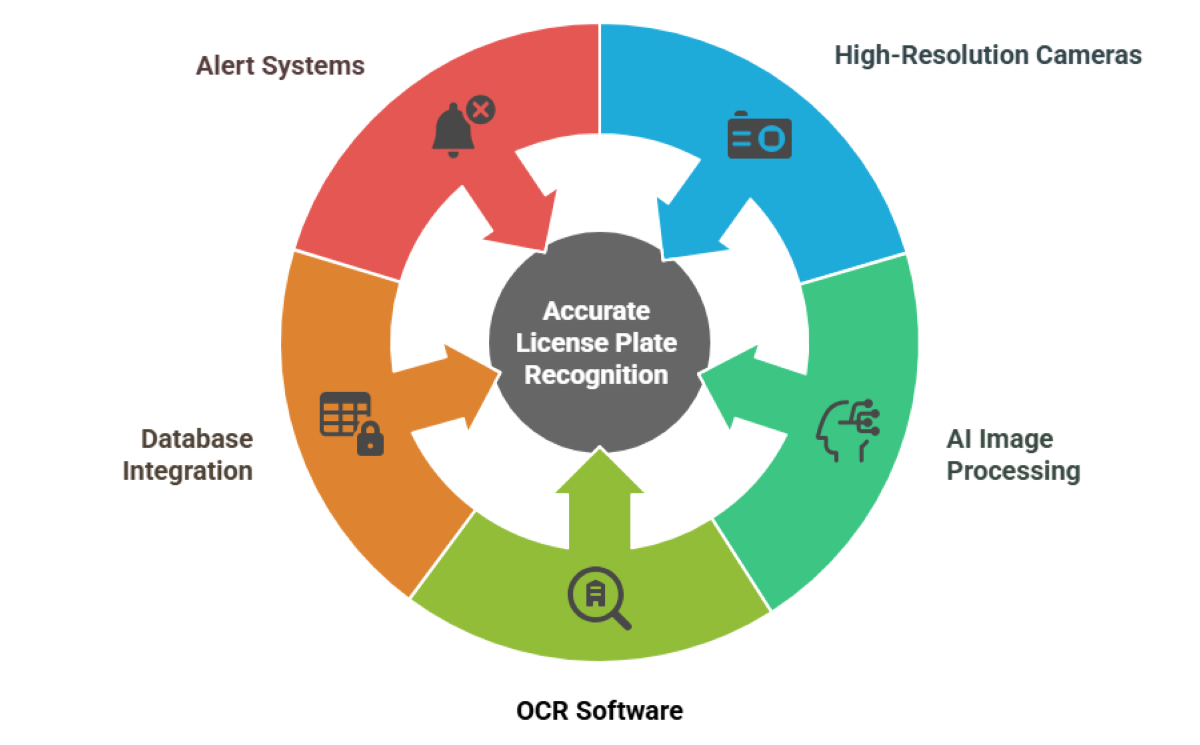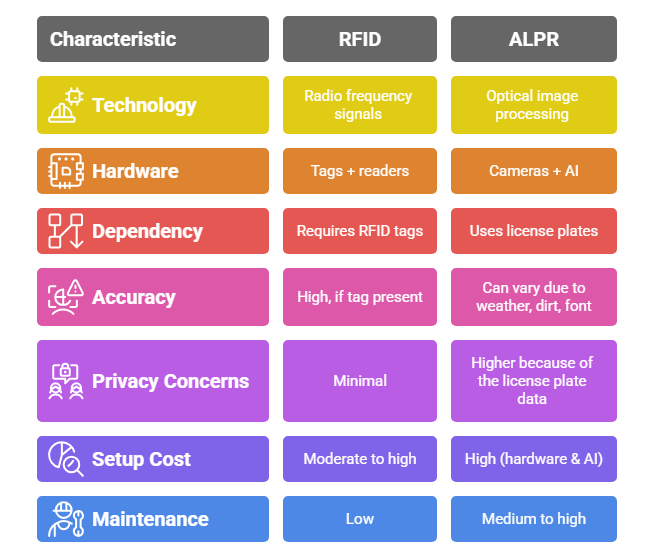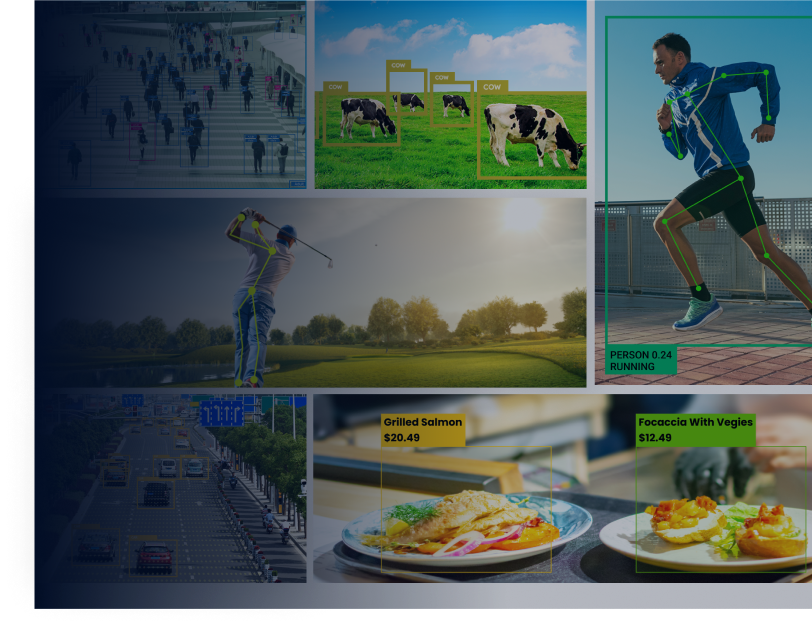Vehicle identification technology has become essential for modern access control systems, with organizations across industries choosing between two primary solutions. RFID vs ALPR comparison reveals that both systems offer distinct advantages, but selecting the wrong technology can lead to costly implementation issues and security gaps.
With over 275 million registered vehicles in the U.S. alone and the global vehicle access control market projected to reach $53.5 billion by 2034, understanding which system best fits your operational needs has never been more critical.
These technologies have changed how transportation, logistics, security, and smart city initiatives manage vehicle access and monitoring across diverse operational environments.
What is RFID technology?
Radio Frequency Identification (RFID) is a wireless technology that uses electromagnetic fields to automatically identify and track tags attached to vehicles or objects. An RFID system operates through radio waves transmitted between tags and readers, enabling seamless identification without physical contact. This technology has become increasingly popular for vehicle tracking and access control due to its reliability and ease of implementation.
How does an RFID vehicle identification system work?

RFID technology functions through a simple yet effective communication process between key components:
- RFID tags: Small electronic devices containing a microchip and antenna that store unique identification data and respond to reader signals within specific frequency ranges.
- RFID readers: Stationary or handheld devices that emit radio frequency signals to activate nearby tags and capture their transmitted data for processing.
- Frequency bands: Different operating frequencies (125 kHz, 13.56 MHz, 860-960 MHz) determine reading range, data capacity, and application suitability for various environments.
- Data processing: Backend systems receive tag information from readers and cross-reference it with databases to grant or deny access permissions.
- Power sources: Active tags contain batteries for long-range transmission, while passive tags draw power from reader signals for cost-effective short-range applications.
Top RFID applications
RFID technology serves diverse applications across multiple industries, providing automated identification and tracking capabilities:
- Automated toll collection systems: Highway toll systems use RFID tags mounted on windshields to automatically charge vehicles passing through toll booths, reducing traffic congestion and processing time.
- Smart parking management solutions: Gated parking facilities use RFID cards or stickers to grant authorized access, allowing residents and employees to enter without manual intervention.
- Secure vehicle access control: Corporate campuses and secure facilities deploy RFID systems to control vehicle entry, ensuring only authorized personnel can access restricted areas.
- Commercial fleet tracking and management: Logistics companies track commercial vehicles using RFID tags, monitoring location, movement patterns, and operational efficiency across their entire fleet network.
Advantages of RFID
RFID technology offers several compelling benefits that make it particularly effective for controlled access environments with regular users:
- 99% accuracy rate for vehicle identification: RFID systems achieve near-perfect identification rates when tags are properly positioned, eliminating false readings.
- All-weather performance and reliability: Radio frequency signals remain unaffected by rain, snow, fog, or lightning conditions, providing consistent performance in all weather environments without degradation.
- High-speed vehicle processing: RFID readers identify vehicles instantly as they approach, enabling high-speed access without requiring vehicles to stop or slow down significantly at entry points.
Disadvantages of RFID
Despite its advantages, RFID technology has several limitations that may impact its suitability for certain applications and environments:
- RFID tag dependency issues: Users must possess functioning RFID tags at all times, creating potential access issues when tags are lost, damaged, or forgotten during critical access needs.
- Limited reading range for vehicle detection: Most RFID systems operate within short to medium distances, requiring precise vehicle positioning for reliable tag detection and data transmission capabilities.
- RFID security and cloning vulnerabilities: RFID tags can be cloned or stolen, potentially allowing unauthorized access if proper encryption and security protocols aren’t implemented throughout the system.
What is ALPR technology?
Automatic License Plate Recognition (ALPR) is a cutting-edge technology that uses advanced cameras equipped with artificial intelligence to capture and read license plate information automatically.
This sophisticated system combines optical character recognition (OCR) with machine learning algorithms to identify vehicles based on their registration plates. ALPR has proven highly effective in law enforcement, traffic management, and commercial applications requiring real-time vehicle identification.
How does an ALPR camera system process license plates?

ALPR technology employs multiple advanced components working together to achieve accurate license plate recognition:
- High-resolution ALPR cameras: Specialized imaging devices capture clear license plate images under various lighting conditions, including infrared capabilities for low-light environments.
- AI-powered image processing: Advanced algorithms enhance captured images by adjusting brightness, contrast, and focus to optimize character recognition accuracy and handle challenging conditions.
- Optical character recognition software: AI-powered OCR software analyzes processed images to identify individual characters, converting visual license plate data into digital text format.
- Real-time database integration: Recognition results are instantly compared against authorized vehicle databases, enabling real-time verification and automated decision-making for access control.
- Automated alert and notification systems: Automated notifications trigger when unauthorized or flagged vehicles are detected, providing immediate security alerts to monitoring personnel or systems.
Applications of ALPR systems in the real world
ALPR systems serve critical functions across various sectors, delivering enhanced security and operational efficiency:
- Law enforcement vehicle identification: Police departments use mobile and fixed ALPR cameras to identify stolen vehicles, track suspects, and monitor traffic violations in real-time.
- Border security and customs control: Immigration and customs agencies deploy ALPR systems at checkpoints to verify vehicle authorization and detect suspicious cross-border movements automatically.
- Smart city traffic management systems: City traffic authorities utilize ALPR for congestion monitoring, toll collection, and automated traffic flow optimization across urban transportation networks.
- Automated parking solutions for commercial facilities: Shopping centers, airports, and office complexes implement ALPR for ticketless parking, enabling seamless entry and exit while improving customer experience.
Pros of ALPR
ALPR systems provide unique capabilities that make them suitable for complex identification and monitoring requirements across diverse operational environments:
- Universal license plate compatibility: ALPR works with any vehicle’s existing license plate, eliminating the need for additional hardware or user credentials for vehicle identification and access control.
- Advanced vehicle analytics and monitoring: Systems capture detailed vehicle movement data, enabling advanced analytics, traffic pattern analysis, and security monitoring capabilities beyond simple access control functions.
- Law enforcement database integration: ALPR can cross-reference license plates against law enforcement, stolen vehicle, and security databases for enhanced safety and compliance monitoring in real-time.
Cons of ALPR
ALPR technology faces several challenges that may limit its effectiveness in certain environments and applications requiring consistent performance:
- Weather and environmental impact on accuracy: Camera performance can be affected by weather conditions like dirt accumulation, extreme lighting, or physical obstructions blocking license plate recognition capabilities.
- Variable recognition rates and accuracy: Recognition rates may decrease with damaged plates, non-standard fonts, or foreign license plate formats not included in training databases or system configurations.
- High initial investment and hardware costs: ALPR systems require considerable investment in specialized cameras, AI processing hardware, and software licensing for optimal performance and deployment scalability.
RFID vs ALPR comparison

At Folio3 AI, we lead AI transformation by developing advanced ALPR solutions that deliver reliable performance even in challenging conditions, such as low-light environments and high-speed traffic scenarios.
When should you choose RFID/ALPR for your vehicle access control system?
The choice between Radio Frequency Identification (RFID) and Automatic License Plate Recognition (ALPR) depends on your specific operational requirements, security needs, and infrastructure constraints.
Use-case analysis
Understanding the operational environment and user requirements is crucial for selecting the most effective vehicle identification technology for your specific application:
- Employee parking facilities: RFID systems excel in corporate environments where employees use assigned parking spaces regularly, providing reliable access control with minimal daily operational overhead.
- Residential gated communities: Controlled access environments benefit from RFID’s consistency and cost-effectiveness, allowing residents to enter seamlessly without weather-related performance issues.
- Public parking and commercial facilities: ALPR performs better in high-traffic areas where visitors and customers need access without pre-issued credentials or physical hardware requirements.
- Law enforcement and security applications: Open environments requiring universal vehicle identification leverage ALPR’s ability to read any license plate without additional user equipment or registration processes.
Best practices for business and government vehicle management
Selecting the optimal technology depends on organizational scale, user base characteristics, and long-term operational objectives for vehicle access control:
- Small to medium facilities: Organizations with 50-200 regular users should consider RFID for its lower total cost of ownership and reliable performance in controlled access scenarios.
- Large-scale government operations: Municipal and federal facilities requiring comprehensive vehicle monitoring benefit from ALPR’s integration capabilities with existing surveillance and security infrastructure systems.
- Mixed-use commercial properties: Facilities serving both regular tenants and public visitors should evaluate ALPR for its universal compatibility and reduced administrative overhead for user management.
- Critical infrastructure security: High-security environments benefit from ALPR’s ability to cross-reference license plates against law enforcement databases for enhanced threat detection and response capabilities.
Hybrid RFID and ALPR integration solutions
Combining both technologies creates detailed vehicle identification systems that maximize operational benefits while minimizing individual technology limitations and security gaps:
- Authorized user fast-track access: Deploy RFID for employees and regular users to ensure rapid, reliable entry while maintaining ALPR for visitor verification and backup identification capabilities.
- Multi-layer security implementation: RFID will be used as the primary access method, with ALPR providing secondary verification and comprehensive activity logging for enhanced security monitoring and audit trails.
- Visitor management integration: Implement ALPR for temporary access and visitor processing while utilizing RFID for permanent credential holders, creating seamless access control for different user categories.
- Comprehensive analytics and reporting: Combine data from both systems to generate detailed vehicle movement reports, security analytics, and operational insights for improved facility management and decision-making.
Case study: Smart City ALPR implementation results
Cities worldwide are deploying ALPR systems for intelligent traffic management, enabling the automated monitoring of vehicle flows, congestion detection, and the enforcement of traffic violations.
Our case study demonstrates how Folio3 AI developed a thorough ANPR solution for an East Asian video analytics company, utilizing machine learning and computer vision to read vehicle number plates from images, videos, and live camera streams with exceptional accuracy in real-world conditions.
Our achievements:
- Advanced OCR technology development: Developed proprietary optical character recognition algorithms capable of reading both printed and handwritten license plates in standard authority-approved formats.
- Real-time processing and edge computing: Implemented edge computing capabilities, enabling instant vehicle identification and response for high-traffic urban environments requiring immediate decision-making.
- Multi-format license plate compatibility: Created flexible systems handling diverse license plate formats, fonts, and regional variations to ensure broad compatibility across different jurisdictions.
- Seamless infrastructure integration: Built seamless interfaces with existing city infrastructure, traffic management systems, and law enforcement databases for comprehensive urban surveillance networks.
- Scalable smart city architecture: Designed deployable on-site solutions that can expand from single intersection monitoring to city-wide traffic management systems.
RFID vs ALPR: Which vehicle identification technology should you choose?
The choice between Radio Frequency Identification (RFID) vs Automatic License Plate Recognition (ALPR) ultimately depends on your specific operational requirements, user base, and security objectives. RFID excels in controlled environments with regular users who can carry tags, offering reliable, cost-effective access control with minimal maintenance requirements.
ALPR offers superior flexibility for open environments that require universal vehicle identification without additional hardware, making it ideal for public facilities, law enforcement, and comprehensive traffic management applications.
When selecting the technology that best serves your vehicle identification needs, consider your long-term goals, budget constraints, and technical requirements.
Learn more about ALPR And ANPR
Why choose Folio3 AI for custom ALPR development and implementation?
Folio3 delivers cutting-edge ALPR solutions designed to meet the demanding requirements of modern vehicle identification and traffic management systems.
- End-to-end AI integration and cloud solutions combine edge computing and cloud processing to deliver real-time vehicle recognition with scalable backend analytics and data management capabilities.
- Custom ALPR model training for regional license plates ensures optimal accuracy regardless of local plate formats, fonts, or design variations specific to your geographic area.
- High-speed accuracy and Real-Time alert systems enable instant vehicle identification and automated response systems for time-critical security and traffic management applications.
- Scalable ALPR architecture for any deployment size adapts seamlessly from small installations like gated communities to large-scale deployments including smart cities, highway monitoring, and toll booth networks.
Frequently asked questions
Is RFID manual or automatic?
RFID is completely automatic and requires no human intervention once the system is installed. When an RFID-tagged vehicle approaches a reader, the tag is automatically detected and processed within milliseconds. This hands-free operation makes RFID ideal for high-volume access control and fleet management applications.
Which is cheaper, RFID or ANPR?
RFID systems typically have lower initial hardware costs, with readers ranging from $30 to over $2,500, depending on the reader type, features, and application, while ALPR systems require more expensive cameras, with fixed ANPR cameras typically ranging from $500 to $2,000, depending on resolution and additional features. However, ALPR has lower operational costs since it doesn’t require physical tags for each vehicle, whereas RFID systems need individual tags for every tracked vehicle.
What are the three types of RFID?
The three main types of RFID tags are Active tags (which have their own power supply and offer the longest range), Passive tags (which draw power from reader signals and are the most cost-effective), and Semi-Passive tags (which have their own power source but rely on reader signals to transmit data).
Can RFID and ALPR work together?
Yes, RFID and ALPR systems work excellently together and are often deployed as complementary technologies. RFID can handle registered vehicles with tags for fast, seamless access, while ALPR captures and processes unregistered vehicles or serves as a backup verification system. This hybrid approach maximizes security, provides redundancy, and accommodates both tagged and non-tagged vehicles in the same facility.

Laraib Malik is a passionate content writer specializing in AI, machine learning, and technology sectors. She creates authoritative, entity-based content for various websites, helping businesses develop E-E-A-T compliant materials with AEO and GEO optimization that meet industry standards and achieve maximum visibility across traditional and AI-powered search platforms.










